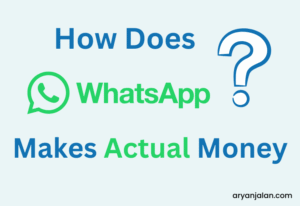Lead generation success is sought by many but attained by only a few, even in today’s digitally powered B2B business environment. Research indicates that over 53% of B2B marketers dedicate over half their marketing budget to generating high-quality leads.

However, 68% of B2B companies are still struggling with lead generation.
This is mainly because B2B businesses have multiple key decision-makers, and building trust and demonstrating value to the entire organization involves several intricate buying processes.
Other lead generation challenges for B2B companies include
- finding and contacting the appropriate decision-makers,
- keeping up-to-date and accurate databases,
- producing engaging content, and
- adjusting to changing trends in digital marketing — all at the same time.
Thus, it is super important for B2B SaaS marketers to approach lead generation strategically. This blog discusses the 10 best lead generation strategies for B2B SaaS businesses that may work wonders!
Let’s get started!
Top 10 Lead Generation Strategies for B2B SaaS Businesses in 2025
1. Content Marketing and SEO
60% of marketers report that inbound strategies, primarily SEO and blog content, are their most effective source for generating leads.
To leverage these strategies for lead generation, begin with comprehensive keyword research to identify terms and phrases your target audience uses when searching for solutions your SaaS offers. Utilize these keywords strategically in your content, titles, meta descriptions, and URLs to improve visibility.
Other than this, promoting your content across platforms where your potential customers are active (e.g., Quora, LinkedIn, Twitter) is equally crucial to driving traffic and enhancing organic search visibility.
Additionally, high-quality backlinks and brand mentions from reputable and relevant websites are a testament to the credibility of your content. Engage in guest blogging, participate in industry forums, and create shareable content to attract backlinks. Also, leveraging digital PR to get featured in industry publications can significantly boost your backlink profile and overall SEO efforts.
2. Paid Advertising
Paid advertisements are not the usual route most B2B SaaS marketers want to take. However, when combined with a well-crafted and keyword-optimized landing page, a Google ad can generate high-quality leads. In fact, 68% of B2B businesses use landing pages to generate leads, and the strategy has proved pretty successful.
While there are many different kinds of paid advertising, pay-per-click (PPC) and social media ads are the most widely used ones for B2B SaaS.
a. PPC Ads
PPC ads involve you bidding against your competitors for certain keywords. These keywords are usually phrases your customers use when looking for a solution to their problems. When a user searches for the keyword you are bidding for, they can see your ad.
For example, when you search for “AI chatbots,” you will find a few results tagged as “sponsored.” Those listings are PPC ads.

b. Social Media Ads
Social media ads are the paid advertisements you run on platforms such as Facebook, Instagram, Twitter, and in the case of B2B SaaS companies, LinkedIn also.
It is imperative to clearly define your campaign objectives and KPIs before publishing the ad. Not to mention, your ad copy should be compelling and clearly explain how your SaaS product or service can help them resolve the problems challenging them. Last but not least, you must monitor the analytics for your paid ad campaigns to identify areas in need of improvement.
To focus even more on the ideal demographic for your advertisements, you can also adjust your targeting parameters and highlight specific use cases for your product or service. This is illustrated beautifully in these Facebook ad campaigns done by Mailchimp.

These ads are similar in one common aspect: each one focuses on a single action that can be completed with Mailchimp’s assistance. Rather than employing a very general slogan such as “Launch the most effective email marketing campaigns!” — these ads showcase the platform’s primary use cases and promote their benefits to ideal prospects.
Such tactics help you connect more successfully with the appropriate prospects for your offerings and turn them into leads with high purchase intent.
3. Webinars and Live Events
Webinars and live events are powerful B2B SaaS marketing strategies for
- showcasing your expertise,
- enhancing your brand credibility, and
- attracting new clients
All this by discussing your unique product features or addressing common industry issues.
Remember to advertise your webinars appropriately to boost the number of attendees. Email, social media, and your website are just a few platforms you might use to advertise your webinars. You can answer questions and create a sense of community by interacting with your audience during the webinar to increase engagement. After the webinar, consider contacting the participants to offer more materials or get insightful feedback.
Here’s how to make webinars an effective tool for your company to generate leads:
- Promotion and Registration: Create an engaging landing page with a clear value proposition and promote it via email, social media, and paid ads to boost sign-ups.
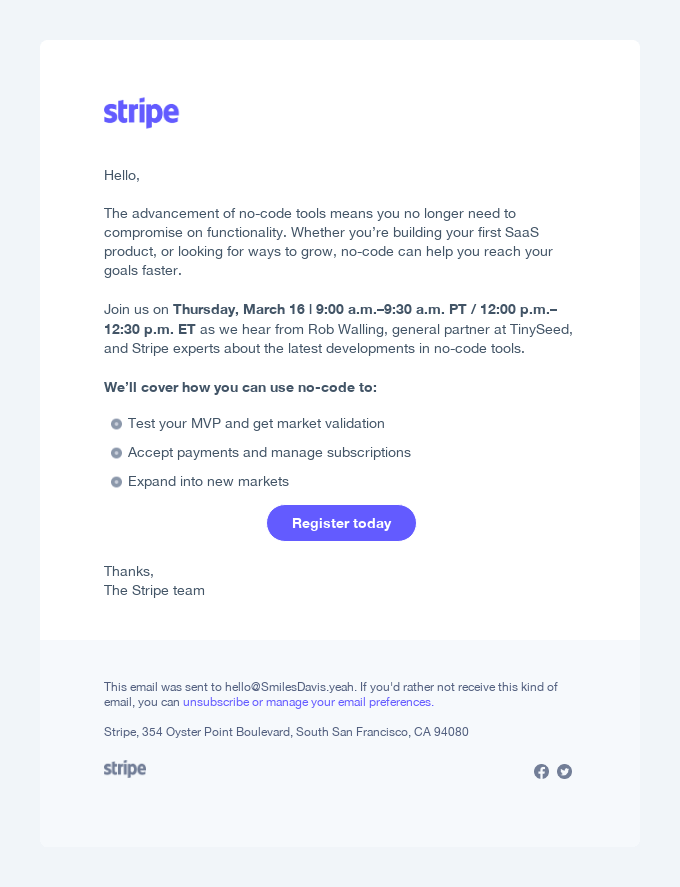
- Engagement and Interaction: During the webinar, encourage participation through polls, Q&A sessions, and live demonstrations.
- Follow up: Post-webinar follow-up is crucial. Send thank-you emails, share a recording of the webinar, and provide additional resources related to the webinar topic. This follow-up not only reinforces your message but also keeps your brand top-of-mind for attendees.

BONUS: Webinar content, specifically, can be re-purposed into blogs, social media posts, videos, case studies, and even eBooks. AI plays a key role in streamlining this repurposing process by automating content adaptation across formats. One efficient way to do this is by using an AI video generator to turn webinar highlights into short, engaging video clips tailored for different platforms. This magnifies the value of the content created once and, thus, acts as an evergreen source for generating leads.
4. Cold Email Outreach
Cold email outreach is essential for B2B SaaS companies to connect with new accounts, establish relationships, and convert leads into customers. To avoid having your emails ignored or marked as spam, follow these effective strategies:
- Recognize who your target market is: Understand your Ideal Customer Profile (ICP) by analyzing demographics (age, gender, occupation) and psychographics (data behaviors, preferences, lifestyles) to tailor your approach.
- Assemble your list: Use databases like Crunchbase to compile a list of prospects that match your ICP.
- Create a compelling subject line: Make your first impression count with subject lines that grab attention and encourage opens.
- Customize your emails: Address the specific needs and problems of your prospects in your email, demonstrating how your product offers a solution. This personal touch increases the likelihood of engagement.
- Follow Up with Diligence: Since initial emails often go unanswered, implement a follow-up strategy with automated emails to remind prospects of your product’s benefits.
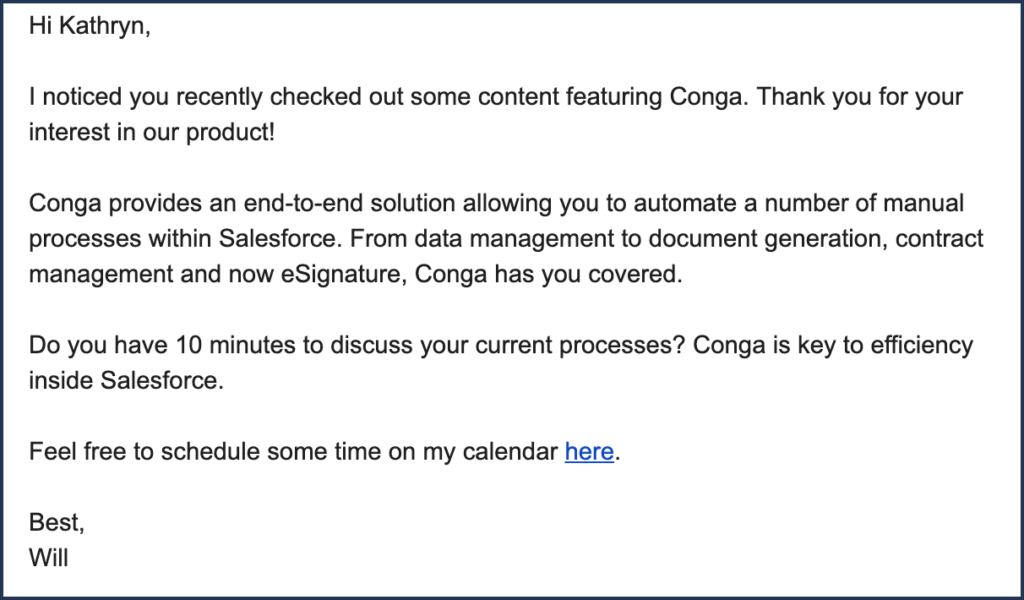
To save time and make the most of your cold email marketing efforts, we recommend the use of email automation. Making sure that relevant content reaches your ideal prospects at the appropriate point in the customer journey is the ultimate goal of email marketing, and automation can help you do exactly that, irrespective of the number of contacts in your lists.
5. Free Trials
Since software products or services offer intangible benefits, most users are skeptical of investing without trying the offering. This can significantly impact your rate of lead generation, not to mention — your entire sales cycle. This is where a free trial comes into play.
Free trials come with no obligations on the part of the users but still offer prospective buyers an experience of the advantages of using your product personally. Your prospects may use it to explore the features, gauge how much value it brings to their business, and see how the product fits into their business routine and requirements.
Here are some tips for crafting an enticing trial offer:
- Outline the USP Clearly: Make it clear to users what they will get from the trial time. Emphasize the salient characteristics and advantages of your offering, concentrating on how it caters to the particular requirements or discomfort areas of your intended consumer base.
- Make it simple to register: Consider registering for a trial that poses numerous questions. Quite overwhelming, huh? The registration process should be as simple as possible.
To start, you should ideally only request the information that is absolutely necessary. Prospects are more likely to sign up when there are fewer obstacles to admission.
For instance, Salesforce has a light and succinct landing page to invite users to try the software for free. The page notes that users don’t require a credit card to sign up, enumerates the product’s benefits in a bulleted format, and provides a phone number for site visitors to contact in the event that they require assistance.
In addition to this, the page features a sign-up form with questions to assist Salesforce in customizing the flow of the free trial for new customers. The form is divided into three steps so users aren’t overwhelmed by too many questions at once.
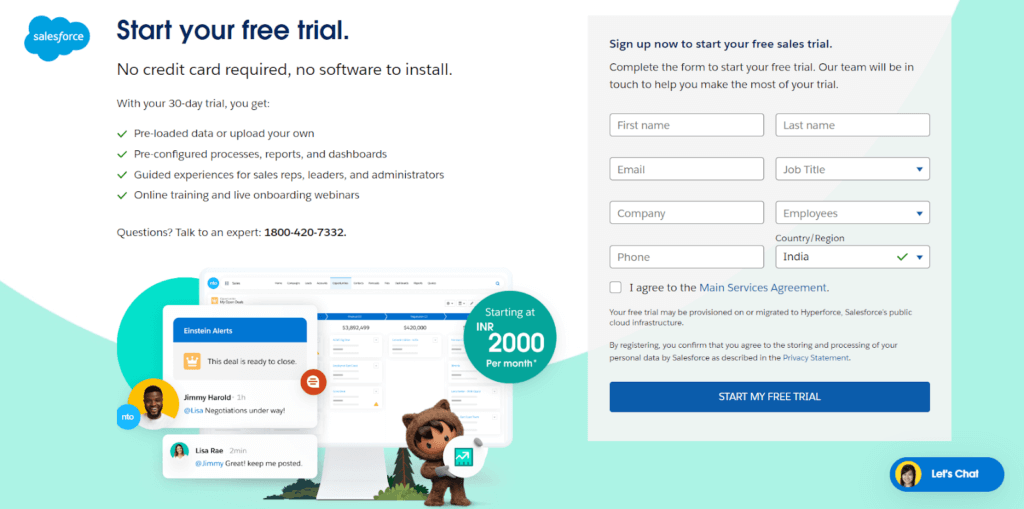
- Lead the Experience: Don’t let your prospects go it alone once they’ve arrived. A guided tour and easily available training that highlight important features and benefits should be given to them.
- Provide Assistance: Offer assistance as soon as possible during the trial time. Make it simple for your prospects to get in touch with you in the event that they have any questions or require assistance by sending out personalized check-ins. This demonstrates your interest in their achievement.
This is done well by Monday.com, a productivity and project management tool. While the software offers a 14-day free trial, they continue sending a course of time-based personalized emails to help the user onboard and quickly get accustomed to the tool’s workflows.
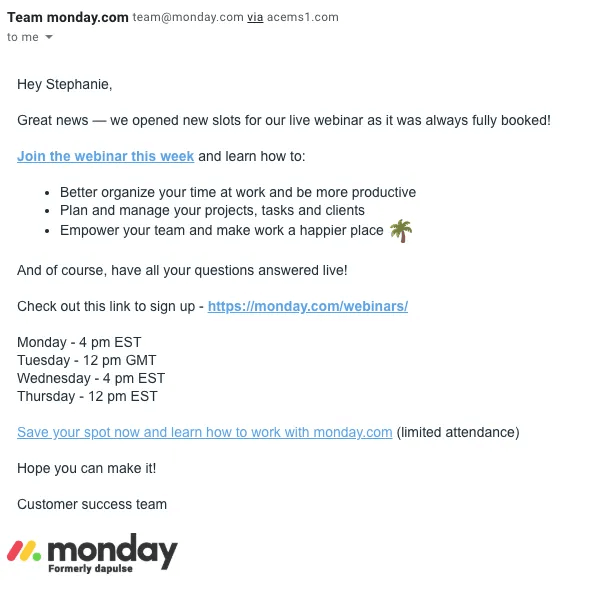
From sharing use cases to value-adding resources, discounts, and more, monday.com is known for getting its users hooked by providing the right assistance at the right time.
- Follow Up Prior to Trial Termination: Don’t wait to follow up until the trial has ended. A few days before the trial finishes, start the discussion about their experience and the next actions to maintain the momentum.
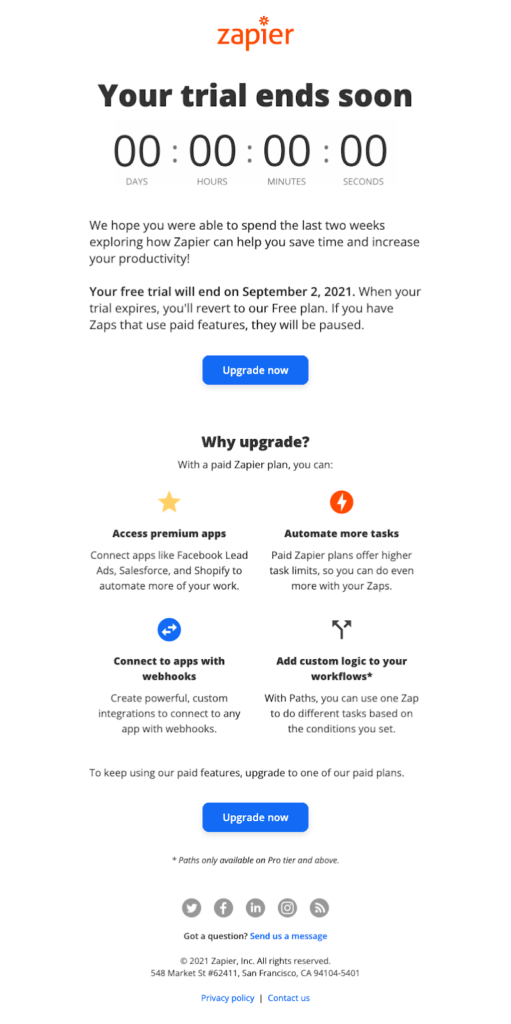
6. Social Selling
In addition to keeping in touch with friends and family, social media can be a great tool for building relationships with your B2B audience. Social media commerce is projected to achieve a valuation of $2.9 trillion by the year 2026.
To leverage social media, start by determining which are the most active sites for your target audience. It’s not necessary to use every social media network immediately. Decide which ones will generate more leads for your company. For most B2B SaaS businesses, this channel will be LinkedIn. In fact, studies show that 39% of B2B marketers consider LinkedIn to be a “very effective” channel in helping them reach their marketing goals.
To optimize LinkedIn for social selling:
- Profile Optimization: Ensure your LinkedIn profile reflects your expertise and areas of specialization.
- Content Sharing: Post relevant content like webinars, case studies, and articles to address your audience’s challenges.
- Engagement: Engage with potential customers by commenting on relevant posts, answering questions, and participating in industry groups to establish your presence and authority.
- Sales Navigator: Use LinkedIn’s Sales Navigator to gain insights into your prospects’ interests and tailor your outreach accordingly.

By interacting with your prospects on a regular basis and cultivating fresh, natural connections, you will become seen as an informed resource. You’ll be able to gain your audience’s trust over time as well.
Since prospective customers are more likely to consider your SaaS solution when they perceive you as a reliable authority, building this trust can go a long way in generating high-quality leads.
7. Case Studies and Testimonials
Let’s face it. The power of social proof and real-world success stories should never be underestimated. In the case of B2B SaaS businesses, case studies and customer testimonials can be helpful in persuading potential customers of the benefits of your B2B SaaS product or service.
A case study provides a detailed analysis of how your product benefited a particular real-world client. Case studies, when combined with endorsements and reviews, can provide strong social proof for generating and converting B2B SaaS leads.
It is especially useful in the B2B scenario, where buyers are typically risk-averse and analytical. They don’t want to waste money on an ineffective solution; instead, they want a strong return on investment (ROI). Providing prospects with this kind of social proof is a great method to earn their trust.
One way to get started is by contacting your happy clients and asking them to share their stories. The stories you select should be centered around the difficulties that your intended audience encounters.
Next, you should post your case studies and testimonials in the areas where your prospects are most likely to find them. This can be discussed in sales interactions, on your blog, on your website, etc.
For your case studies, you might also think about building a resource library. You can group them according to industry, type of problem solved, or product used for easier accessibility.
Intercom does this well. Under their “Customers” section, you can see a rotating roster of their esteemed clients, as well as pages upon pages of case studies.
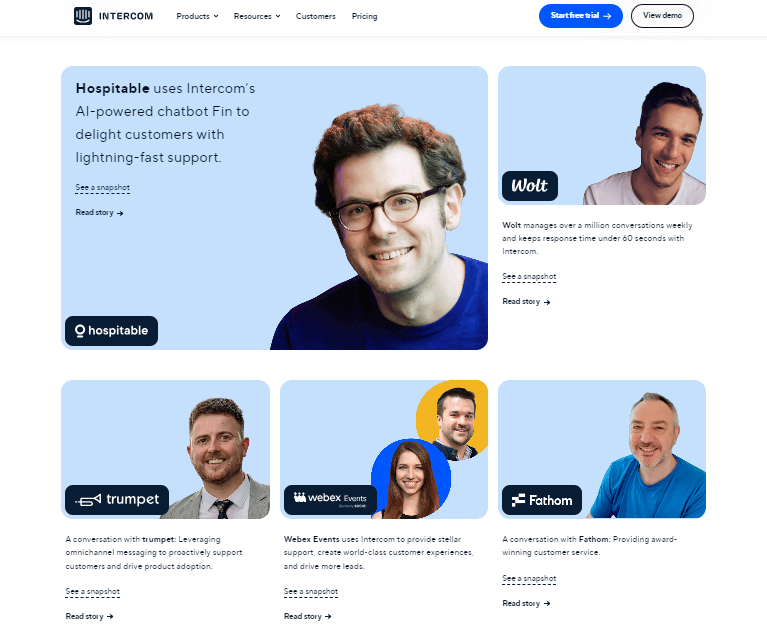
When a prospect interacts with a case study, it indicates that they recognize the value in your product and are encountering comparable issues.
This is your chance to connect, learn about their unique needs, grow the relationship, and show them how your product may be of assistance. You may successfully produce highly qualified leads for your SaaS product with the help of this.
8. LinkedIn InMail
Using LinkedIn InMail to generate B2B leads can be an effective strategy. One of the best features of InMail is its built-in analytics. This makes it simple to target those who make purchases on behalf of their companies.
If you are writing an InMail, make sure to keep it concise and get to the point quickly. Inform the lead of your motivation for pursuing them and your goals for getting in touch. Speak in a genuine and conversational tone and provide a call to action (CTA) that inspires people to reply.
Here’s a sample template you can use to reach out to your prospects:

In addition to these tips, you can increase your chances of getting a response by sending your InMails on a weekday, preferably between 9-10 AM and bringing up any mutual connections or shared experiences while doing so.
Furthermore, you can automate your InMail lead generation using other third-party applications. This software can be used to find target profiles, send connection requests and trawl LinkedIn groups for new prospects.
Keep in mind, though, that LinkedIn InMails have sending limits for specific recipients. If you are looking to run a wide-scale marketing campaign using InMails, you should use LinkedIn’s paid advertising services in the form of Message Ads (or Sponsered InMails) that come with a single CTA, and Conversation Ads that come with multiple custom CTAs.
9. Affiliate and Referral Marketing
Affiliate and referral marketing strategies involve your current customers promoting your product or service to their networks, effectively leveraging word-of-mouth to expand your customer base in return for some incentive. Why do they work? It is because 88% of consumers trust recommendations from people they know, over and above all other forms of marketing.
To implement referral marketing, you must first choose the kind of incentive you wish to provide your clients. Would you like to offer them a deal? A complimentary trial? A complimentary item? After determining the kind of incentive, you must design a landing page where clients can register for your referral scheme. The contents of your referral program and the ways in which clients can get incentives should be covered on this landing page.
For instance, Dropbox implemented a referral program which significantly increased their user base from 100k to 4 million users in just 15 months—a 3900% growth. Their messaging was very simple: if you install Dropbox on a friend’s computer, Dropbox will give you 500MB of free storage space. There will be an equal amount of storage for your friend as well. The maximum amount of free storage space you can receive is 16GB.
Moreover, Dropbox made the referral workflow extremely straightforward, with multiple sharing options augmented by pre-defined messages. In fact, they even informed users how their invites performed. Combining all of these factors, this renowned referral program turned into a recipe for success. Dropbox even made a presentation on their viral growth which you can click to read here.

To replicate such success, ensure your referral program is straightforward to join and promote, with clear benefits for both the referrer and the referred.
10. Strategic Partnership with Other Businesses
Last but not least, you can revolutionize your approach to generating B2B SaaS leads by forming strategic partnerships with companies that have a similar target audience to yours. These partnerships can involve —
- Co-marketing initiatives: Creating co-branded content like whitepapers or social media posts, or co-sponsoring webinars, podcasts, and live events,
- Co-selling initiatives: Exchanging leads or work deals between each other (for instance, if a CRM tool partners with a meeting booking tool, they can easily exchange leads between themselves for faster and greater chances of conversion),
- Re-selling opportunities: Enabling a partner to independently sell your products or services on your behalf, creating an almost seamless experience
Partnerships can be advantageous for startups as well as for established SaaS companies that have dominated the market for years. Building a partner ecosystem can help you provide your business the ability to make money while using other people’s time and resources in a way that benefits both parties.
Strategic partnerships with complimentary SaaS businesses are a great way to increase the demand for your products or services with minimal effort on your part.
Final Thoughts
Generating B2B leads effectively can help you overcome your sales challenges and attain sustainable business growth. While it may seem daunting, it is certainly not impossible, especially if you follow the strategies highlighted above.
However, the key to successful lead generation is to establish a connection with your target audience, understand their wants and needs, and present your product or service as the answer they have been looking for. You should accept making decisions based on facts, keep abreast of trends, and never stop trying out new strategies.
Explore More My Best Tools List
1. SaaS SEO: The Ultimate Guide to SEO for SaaS Companies
2. 11 Benefits of Automated Invoice Processing
3. Leveraging Customer Data For Targeted SaaS Growth
4. Top 7 Business Trends In 2025: What’s In Store This Year?


